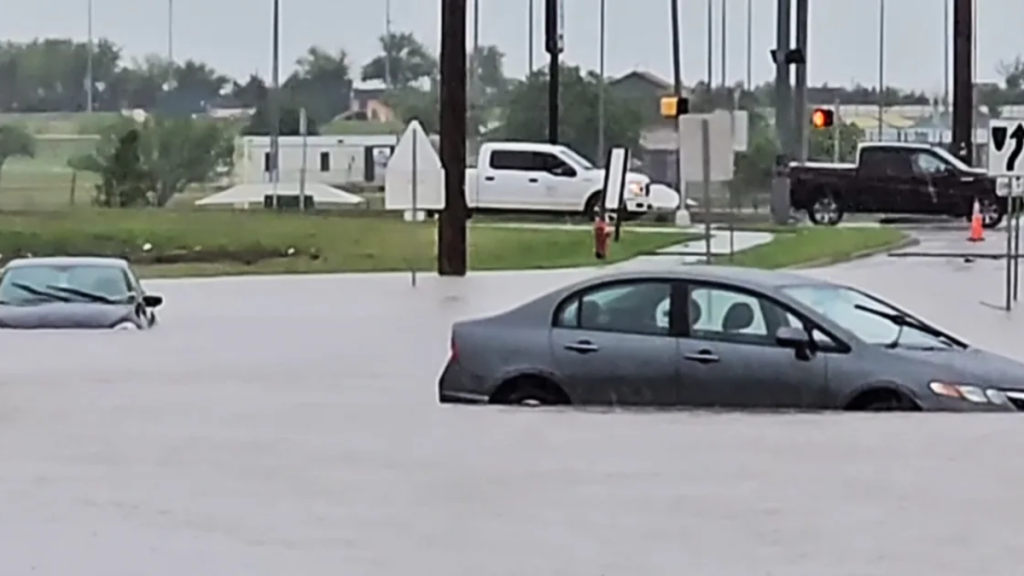Severe thunderstorms swept across Oklahoma on April 30, 2025, triggering deadly flash floods that claimed the lives of two people and left parts of the state underwater. The storms brought relentless downpours that overwhelmed infrastructure, forced road closures, and prompted emergency water rescues.
One of the fatalities occurred in Pottawatomie County, where a 46-year-old man died after driving into a flooded area despite visible road-closure signs. His vehicle was swept off the road and into deep water near the intersection of State Highway 102 and State Highway 59B.
A responding sheriff’s deputy was also swept away during a rescue attempt but was saved and later released from the hospital.
In Lincoln County, another individual lost their life in a separate water-related incident. First responders attempted to rescue the victim, but tragically, the person died before help could arrive. As more rain continues to fall, officials fear the number of casualties could rise.
According to KOCO News, these are the first confirmed flood-related deaths in what’s shaping up to be one of Oklahoma’s most dangerous storm seasons in years.
Torrential Rains Cause Flash Flooding Across the Region
The National Weather Service reported that the storms dumped between 3 and 8 inches of rain across large swaths of central and eastern Oklahoma, with localized areas experiencing even higher totals. Oklahoma City shattered its daily rainfall record for April, and nearby counties were quickly placed under flash flood warnings.

Cities like Lexington and Norman were particularly hard hit, with several neighborhoods submerged and residents forced to evacuate. In Oklahoma City, emergency crews responded to more than 50 water rescue calls as floodwaters stranded drivers on major highways and side streets.
Meteorologists attribute the deluge to a slow-moving storm system that remains locked over the Central Plains. This system is expected to continue producing rain, hail, and the potential for tornadoes in Oklahoma and neighboring states.
The broader region, including Texas, Arkansas, and Missouri, remains under a flood watch, with forecasters warning that the worst may not yet be over. According to The Washington Post, meteorologists are closely monitoring the potential for more flash flooding as the storms linger.
Emergency Response and Public Safety Measures
Local and state authorities have mobilized in response to the flooding, urging residents to stay off the roads and avoid driving into high water. Emergency management officials have emphasized the message: “Turn around, don’t drown,” to prevent further loss of life.
Rescue operations have been underway since early Tuesday evening, with emergency personnel working through the night to assist stranded motorists and evacuate flooded homes. In some areas, schools were closed, and public services were disrupted due to dangerous conditions.
The Oklahoma Department of Emergency Management and the American Red Cross have set up emergency shelters for displaced residents. Meanwhile, utility crews are working to restore power in areas where infrastructure was damaged by floodwaters and lightning strikes.
The state’s governor has not yet declared a formal state of emergency, but local officials in affected counties are urging for swift action and financial assistance to aid recovery efforts.
Continued Weather Threats and Long-Term Concerns
The National Weather Service warns that the storm system could stall over the region for another 24 to 48 hours, increasing the risk of flash flooding and severe weather outbreaks. Residents are advised to monitor updates through official channels and prepare for additional rainfall, especially in flood-prone areas.
Looking ahead, officials worry about the long-term impacts of repeated flooding on infrastructure, agriculture, and public health. Standing water could increase the risk of mosquito-borne illnesses, while crop damage may impact local food supplies.
Climate experts have noted that the frequency and intensity of such extreme weather events are becoming more common, possibly due to shifting climate patterns. Oklahoma, already prone to spring storms, may now need to invest more heavily in flood mitigation strategies.
Conclusion: Community Resilience Amid Tragedy
As Oklahoma begins its recovery, the focus is on saving lives, providing aid, and preparing for what may come next. The tragic loss of life serves as a reminder of nature’s unpredictability and the importance of heeding weather warnings.
Communities across the state are rallying together to support one another through volunteer efforts, donations, and emergency response coordination. While the road to recovery may be long, Oklahomans have shown resilience in the face of disaster time and again.
For real-time weather alerts and emergency updates, visit the National Weather Service or your local emergency management agency.
Disclaimer – Our team has carefully fact-checked this article to make sure it’s accurate and free from any misinformation. We’re dedicated to keeping our content honest and reliable for our readers.
